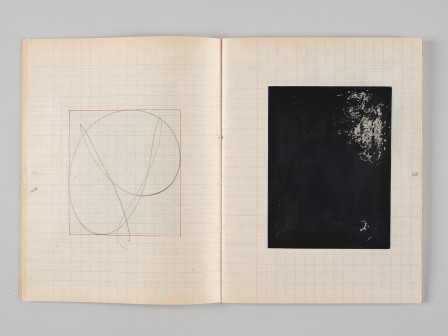RIGHI (François). Combustis Libris.
Ivoy-le-Pré, s. n. [chez l’artiste], 2019. Ancien cahier d’écolier (22 x 17 cm) de 92 pp., cousu, couverture peinte. 44 monochromes noirs charbonnés au brunissoir, 44 dessins originaux à la mine de plomb et 8 notices manuscrites tirées d’un catalogue de la librairie Paul Jammes. Exemplaire unique, daté et signé.
Épuisé (collection particulière, Paris).






Texte de la vidéo publiée par MADTV :
Le titre reprend celui d’un ancien catalogue de la librairie Paul Jammes, publié à Paris en 1967. Il y a 44 rectangles noirs, peints au recto de toutes les pages. Leur surface dépend exactement des limites dans lesquelles s’inscrit la figure dessinée au verso. Celle-ci répète le geste d’une ligne continue qui se recoupe 6 ou 8 fois, selon un tracé identique. Une fois peintes à la gouache, les surfaces ont été lustrées au brunissoir, afin d’acquérir une qualité de noir évoquant le charbon d’un bois brûlé. D’où la copie manuscrite, sur la première et la dernière page, de 8 des 916 notices dudit catalogue Paul Jammes, intitulé Le Bûcher bibliographique, consacré à une « collection d’ouvrages condamnés, poursuivis et détruits ». Exemple : Louis-Gorin de Saint-Amour. Journal de M. de Saint-Amour, docteur de Sorbonne, de ce qui s’est fait à Rome dans l’affaire des Cinq Propositions. Imprimé par les soins dudit Sieur de Saint-Amour, 1662. Saint-Amour fut envoyé à Rome pour tenter d’empêcher la condamnation des Cinq Propositions. À son retour, il rédigea ce journal, affirmant : « Je n’ai écrit que ce que j’ai vu et entendu et lorsque j’en avais encore la mémoire toute fraîche », mais il y fait preuve de beaucoup de partialité et de violence. Lenglet-Dufresnoy juge que cette relation est : « une satyre très sanglante de la Cour de Rome… » Après avoir fait examiner ce livre par une commission de docteurs, Louis XIV rendit en son Conseil, le 4 janvier 1664, un arrêt qui condamna ce livre à être brûlé par la main du bourreau.
COMBUSTIS LIBRIS is an old 92-page schoolboy’s exercise book. The title echoes that of a catalogue of the bookshop of Paul Jammes, published in Paris in 1967. There are 44 black rectangles, painted on the recto of every page. Their area depends exactly on the dimensions of the figure drawn on the verso. This figure repeats the feature of a continuous line which is stepped back 6 or 8 times, following an identical outline. After being painted with gouache, the surfaces have been burnished with a polisher to acquire a dark shade suggestive of the blackening of burnt wood. Hence the manuscript copy, on the first and last page, of 8 of the 916 entries in the said catalogue of Paul Jammes, entitled The Bonfire of Books, devoted to a “ collection of condemned, proscribed and destroyed books.”
Example : Journal of M. de Saint-Amour, doctor at the Sorbonne, on the events at Rome in the affair of the Five Propositions. Printed at the instance of the author, 1662. Saint-Amour was sent to Rome to try to prevent the condemnation of the Five Propositions. On his return, he produced this journal […], but displays in it much prejudice and violence. Lenglet-Dufresnoy considers that this account is: “a very bloody satire upon the Court of Rome…” Having had the book examined by a learned commission, Louis XIV in Council on 4 January 1664 issued a decree condemning this book to be burnt by the hand of the executioner.


